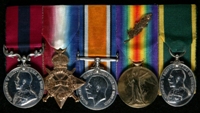

(L to R) Distinguished Conduct Medal; 1914-15 Star; British War Medal; Allied Victory Medal with 'Mentioned in Despatches' oak leaves; Territorial Efficiency Medal
George was born on the 6th July 1886 in Gorton, Manchester. We don't know anything about his early life or his family.
In mid 1914 George lived in the Manchester area and decided to join the 8th Battalion of the Manchester Regiment. This was a unit of the Territorial Force based in Ardwick. As a Territorial George kept his civilian job, although we don't know what this was, and trained to be a soldier during evenings and weekends. He was given the service number 2093.
When the First World War broke out that August George and the 8th Battalion were called into service. They left the UK for Egypt on the 10th September, arriving on the 25th.
After less than a month in Egypt, on the 19th October George was sent to Cyprus. This was a Turkish colony administered by Britain. As Britain and Turkey were now at war George and the 8th Battalion took part in the British annexation of the island. They stayed there until the 23rd January 1915 when they returned to Egypt.
George went to war in May 1915 when the 8th Battalion landed in Gallipoli. We can be sure that he took part in the attack on the village of Krithia that began on the 4th June. This had been intended to be captured during late April when the first Allied troops landed, but the Turks had been able to hold them off. George and the 8th Battalion advanced further than most British units, but this meant when the Turks counter attacked they were cut off and forced to withdraw, taking heavy casualties.
For his conduct during May and June George was Mentioned in Despatches that were written by General Sir Ian Hamilton on the 22nd September 1915. They were published in the London Gazette on the 5th November.
We don't know anything about the rest of George's time in Gallipoli. The 8th Battalion was evacuated back to Egypt in December and served in Egypt throughout 1916 before moving to France to fight on the Western Front in March 1917.
George though spent at least some of this time back in the UK. On the 29th November 1916 he married Ethel Kenny in Gorton. Their son John was born on the 19th August 1918. We don't know whether George had spent time in France between these dates, or whether he was serving in the UK whilst he recovered from an injury or illness.
In early 1917 soldiers serving in Territorial Force units were given new service numbers. The 8th Battalion was allocated the range 300001 to 350000. George was given 300279. At this time he held the rank of Corporal.
By March 1918 George had been promoted to Sergeant and returned to the 8th Battalion in France. On the 21st the German Army launched a huge offensive against the British and French Armies. They hoped to win the war before too many American troops could arrive to fight them. At first the attack was extremely successful. Many Allied units were cut off, and thousands of soldiers were killed or captured.
The 8th Battalion had been in the rear on the 21st, but were rushed to the front to help in the defence. They took up positions around the village of Ablainzevelle and fought off German attacks for the rest of the month.
We believe it was during this period that George carried out an act that led to the award of the Distinguished Conduct Medal on the 3rd September. His citation for the act is as follows:
For conspicuous gallantry and devotion to duty in charge of an advanced post, with instructions to watch a village owing to the position of the enemy being uncertain. He advanced through the village with one man, until a strong party of the enemy were encountered. One of these he shot. He sent back important information and located a machine gun. Throughout the day he kept in touch with the enemy, and showed great initiative and courage.
The Allies had stopped the advance by July and began one of their own in August, leading to the end of the war on the 11th November. George was demobilised and released from the Army during 1919, after 5 years and 8 days service.
George must have missed the Army because on the 9th June 1920 he rejoined the 8th Battalion. He was working as a labourer. The Army had changed its system of service numbers again, so George was now 3512008. George quickly regained his wartime rank of Sergeant.
After 3 years service George decided to leave the 8th Battalion. He had been awarded the Territorial Efficiency Medal on the 24th May 1923. This was awarded for 12 years in the TA, but George could count his service during the war twice. His medal was presented by the Commanding Officer at a parade attended by the entire 8th Battalion. He was discharged 2 weeks later, on the 8th June.
George lived at 13 Church Street in Gorton at this time. We don't know what civilian jobs he held. We believe he and Ethel had 2 more children, William in 1929 and Kathleen in 1931.
George died between April and June 1971. He was 84 years old. His medals were donated to the Museum of the Manchester Regiment in December 1993.




